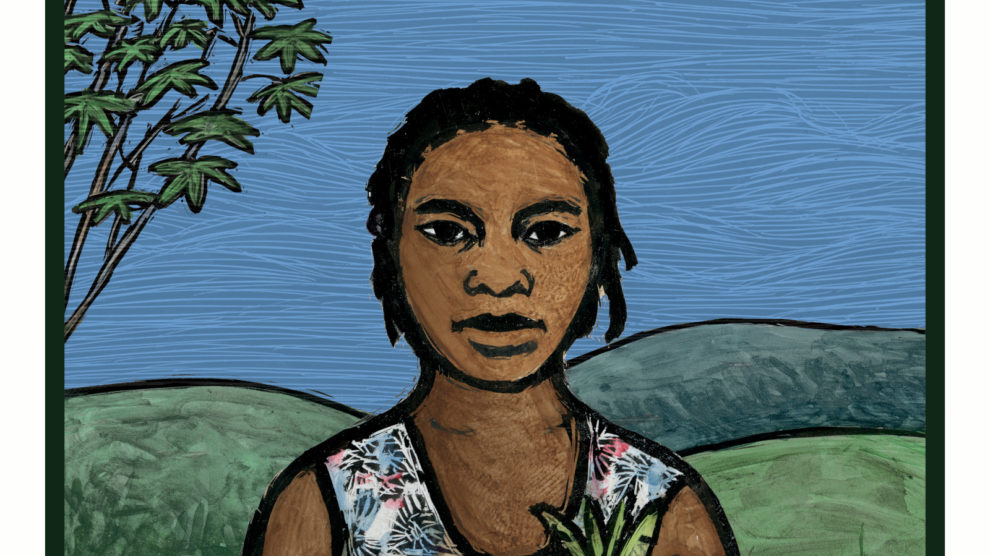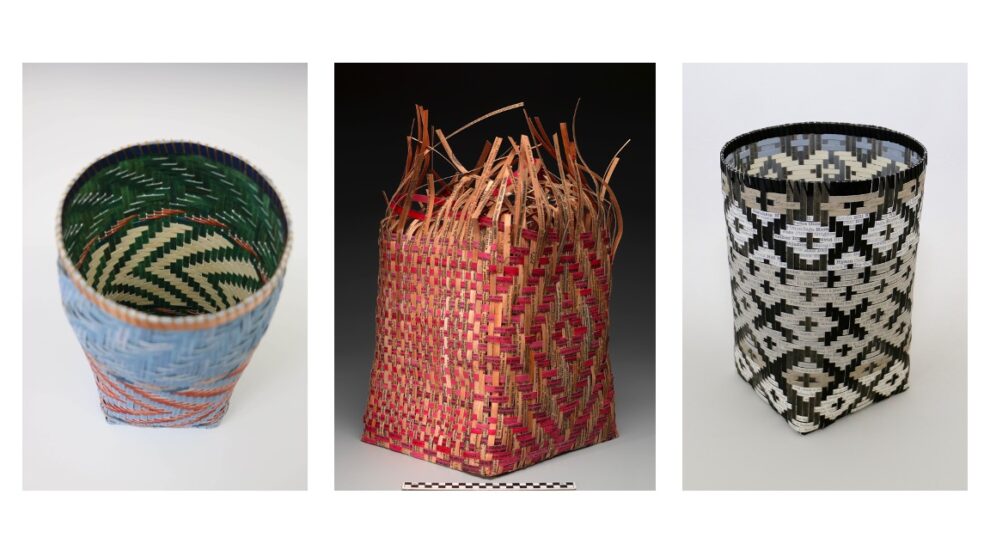A Just Transition for the Building Sector: The Architecture Lobby’s Retroactive Roadmap
By Valérie Lechêne
Volume 23, number 2, People’s Green New Deal

The Green New Deal (GND) is the American government’s most compendious response to the existential threat of the climate crisis. At its core is the idea of a just transition. This term first emerged in labor movements in the 1970s as a response to the politicized dichotomy of “jobs versus environment” and “hippies-versus-hardhats” and outlines the process of deep decarbonization strategized with and for those most impacted by climate change.1 While it is a powerful framework, its federal implementation through a GND is yet to be construed, planned, or enacted.
The built environment—roads, infrastructure, and our public and private buildings—is responsible for 75 percent of annual global greenhouse gas emissions; buildings alone account for 39 percent.2 The built environment’s form and function are dominated by the logic of capital accumulation. Integral to a just transition is the need to reorient this logic towards one that values care, maintenance, and circularity. That’s why the building sector needs something like the GND, which takes advantage of governmental policy’s distributive property to jumpstart large-scale change.
Previous climate action initiatives have gathered the tools to enact carbon neutrality in the built environment. In turn, the resolution gives people the imperative to use them. The Architecture Lobby (T-A-L), a labor organization focused on the built environment, is working to actualize a GND within the building sector. Here, we describe the grassroots, iterative, and incremental process undertaken so far, and lay out a strategy going forward.
As it pertains to our industry, the GND mandates “upgrading all existing buildings in the United States and building new buildings to achieve maximum energy efficiency … through electrification.”3 The resolution’s bottom-up participatory approach echoes with the Lobby’s democratic process and similarly values unionization and cooperative work: “a Green New Deal must be developed through transparent and inclusive consultation, collaboration, and partnership with frontline and vulnerable communities, labor unions, worker cooperatives, civil society groups, academia, and businesses.”4
What’s more, by precisely describing principles and goals while leaving room for creativity in their execution, the GND brings to mind a design brief or an architecture parti. As architects, we know that radical ideas often emerge out of these nebulous starting points and we are trained to respond positively and productively to actualize these kinds of visionary blueprints.
T-A-L’s ethos revolves around analyzing, dismantling, and overcoming the shortcomings of neoliberalism in the industries of architecture, engineering, and construction (AEC). Colloquially referred to as “the Lobby,” T-A-L advocates for a reevaluation of architecture both externally, as it is perceived by the general public, and internally, within the field. T-A-L believes that the work architects do—aesthetic, technical, social, organizational, environmental, administrative, fiduciary—needs structural change to be more rewarding and more socially relevant. 5
Originating in and around New York City in 2013, the Lobby has twenty chapters based in the United States, Canada, the United Kingdom, and Australia, all locally based and adhering to an agreed manifesto and democratic procedure. We are governed by a democratically elected Organizing Committee and a Board of Directors, and communicate through our own online platform and email. Every three weeks, chapter meetings are a space where we discuss responses to current events and emerging movements such as Black Lives Matter and #MeToo. T-A-L also has long-term scope-focused working groups which organize public campaigns, direct actions, publications, and events intersecting with civic, academic, and professional spheres.
Today, T-A-L has three major working groups: a unionization group that bargains for better working conditions with real estate developers, a co-op group that aims to establish a network of worker-owned, democratic architecture firms, and a GND working group that was founded to connect this work with the wider political movement addressing the twin crises of climate change and economic inequality.
In February 2019, T-A-L’s NYC chapter initiated a Lobby-wide conversation on the GND that mobilized a high volume of members across the country and led to the formation of the GND working group. Early conversations acknowledged that the AEC fields’ current ways of addressing climate change are unable to scale because of their complicity with global capital. An example is the US Green Building Council’s (USGBC) certification program commonly known as LEED (‘Leadership in Energy and Environmental Design.’) Established in the 1990s, LEED does not set standards, but rather lets developers pick and choose from a laundry list of greening strategies to aggregate sustainable practices within a building’s design. The process of deciding which strategies to adopt is typically driven by cost efficiency and has high barriers to entry, as the process of getting LEED certifications is time consuming and costly. LEED certifications can be achieved with the complete absence of carbon or energy studies.6 Kansas City architect Bob Berkebile helped shape the first LEED standards and in 2018 he said that “the certification has become: your building is doing a little less damage to the environment than everyone else’s […] but that means you’re still having a negative impact. I think that’s a failure.”7 LEED is an initial attempt at organizing a climate change mitigation system for AEC, but it amounts to greenwashing as it claims ‘leadership’ with regards to climate action in AEC while failing to mobilize the sector in order to meet the targets established by the IPCC and the Paris agreement. LEED certifications alone cannot reach the decarbonization goals required to prevent a climate catastrophe.
Another major initiative within the field is Architecture 2030 (Arch2030). Launched in 2006, Arch2030 educates architects, and more recently with engineers and real estate developers to implement carbon neutrality within architectural projects by the year 2030.8 It does so by providing resources, strategies, and tools geared toward individual projects or modes of practice in architecture, engineering, urban planning, and real estate. Arch2030 is a powerful educational organization that kindled momentum among practitioners of the built environment. But Arch2030 alone is insufficient, as it does not create motivating incentives for skeptics nor keep stakeholders accountable. That’s where the GND comes in: its focus on large-scale systemic change through the distributive property of governmental policy builds on and goes beyond every other climate action plan for AEC. In light of this, T-A-L organized conversational events focused on the GND in order to come up with specific strategies for action.
The first important conversational event happened in Congress in March 2019. The American Institute of Architects (AIA), a professional organization of architects in the US known to coordinate the building industry, endorsed the “Green New Deal Framework” in a public statement. It encouraged Congress “to swiftly enact public policies …1 that will address the dire consequences we’re facing.”9 It prompted a day of exchange between Congress members along with staff (covering 92 percent of the House and Senate) and over six hundred AIA registered architects from forty-eight states and three US territories.10 Half a dozen of these AIA registered architects were also members of the GND working group.
This civic enterprise prompted T-A-L to broadcast its commitment to a GND with a public statement guided by a close reading of the GND H.Res.109. T-A-L’s statement on a GND features four major principles: (1) reform practice, (2) redefine resilience, (3) reassess technology, and (4) re-empower labor.
T-A-L’s GND statement garnered exchanges with Billy Fleming of the Ian L. McHarg Center for Urbanism and Ecology at the University of Pennsylvania (UPenn) and led the Lobby to co-sponsor, co-organize, and participate in a day long conference held at UPenn in September 2019. The event, called ‘Designing a Green New Deal,’11 gathered 1,400 people of various disciplinary backgrounds traveling across the country to attend. Peggy Deamer, who spearheads T-A-L, presented a paper called “Building Power—Bold Visions for a Green New Deal” and participated in a panel discussion. Twenty Lobby members went on stage to publicly present T-A-L’s GND statement. This large-scale conference built momentum by generating numerous connections and further collaborations, along with a sense of collegiality, collectivity, enthusiasm, and cohesion among practitioners of the built environment.
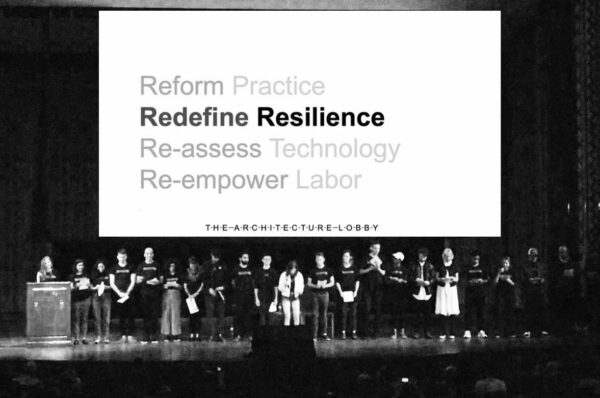
Immediately after, the Lobby began to co-organize a public assembly for the GND set to take place within the congressional district of Representative Alexandria Ocasio-Cortez (AOC). We partnered with the Columbia Buell Center’s initiative “Power: Infrastructure in America” and Francisco Casablanca and Gabriel Hernandez Solano, two architects active within AOC’s team. The assembly, panels, and open brainstorming sessions were centered around three topics: energy, transportation, and government. Designed as a public forum, the event introduced the idea of just transition to experts and the general public.
There were a handful other important conversational events that drew crowds and built community. Design sociologist Damian White at the Rhode Island School of Design held a day long conference, “Climate Futures II,” in December 2019. T-A-L member Elisa Iturbe guest-edited issue 47 of the journal Log, titled “Overcoming Carbon Form,” featuring an interview with Rhiana Gunn-Wright, Policy Director at New Consensus and one of the creators of the GND. And in early March 2020, members of T-A-L participated in Harvard Graduate School of Design’s “Planning a Green New Deal” conference.
In addition to reaching out to other groups, the T-A-L NYC GND working group assembled a chapter kit for internal distribution. The toolkit puts forward specific questions, organizational methodologies, and readings aligned with our climate policy goals for AEC. It fostered activity in our chapters in Boston, New Orleans, Cincinnati, Philadelphia, Los Angeles, London, UK, and Victoria, Australia, thus building a common framework throughout T-A-L. It laid the groundwork for an Earth Day 2020 online workshop series, which highlighted strategies for climate action in AEC across the world.12
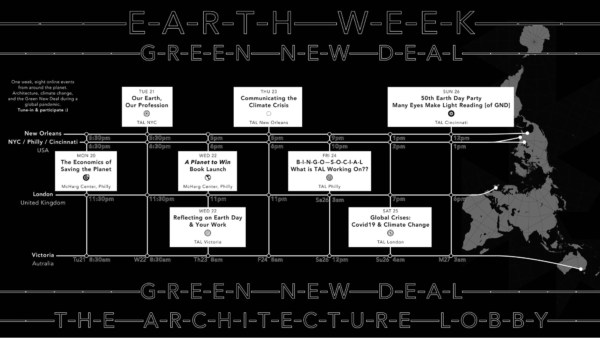
Earth Week’s momentum prompted T-A-L members across the US, Canada, the UK, and Australia to collectively develop a “Guide to Power Mapping” designed to systematically document power dynamics among various stakeholders of the built environment in order to enact climate action. The guide standardized the assembly of empirical information about parties with a vested interest in the built environment, creating a common language of analysis across chapters, despite our varied cultural and governmental contexts. Together, the various power maps can provide an overall roadmap for T-A-L to jumpstart mass participation in an internationalist people’s just transition for the built environment.
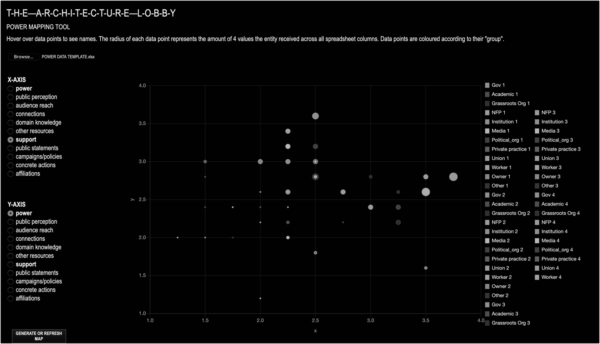
The process of testing the power-map informed T-A-L the need for an overarching campaign strategy. Its construction builds upon the Lobby’s statement on a GND, integrates the tools of Arch2030, and correspondingly formulates policy demands related to education, building practice, and policy. While a federal GND would galvanize T-A-L’s campaign for large-scale impact within the building sector in the US, most strategies can be implemented independently of the resolution.
The redaction of the campaign’s strategy has been stimulated by the critical reading of recently published texts focused on just transitions such as the Labor Network for Sustainability’s 18 strategies for a GND, Saul Levin’s PhD thesis titled A Green New Deal for Federal Lands, the United Nations Conference on Trade and Development (UNCTAD)’s Financing a Global Green New Deal and Boston University Global Development Policy Center’s Geneva Principles for a Global Green New Deal. As of September 2020, this document is still under review.
The strategies are currently being amalgamated on a three-by-three matrix. One axis features spatial scales: local, regional, and international. The other features the three fronts of action: education, building practice, and policy. This format prompts for a fine grain of verbalization of demands, while allowing quick context matching to specific opportunities.
Once the campaign strategy is finalized, power-maps will inform communication tactics designed to diplomatically and effectively impact critical stakeholders in the building sector. The Architecture Lobby is enthralled with engaging and strengthening solidarity within Science for the People’s Green New Deal coalition.
References
- Damian White, “Just Transitions/Design for Transitions: Preliminary Notes on a Design Politics for a Green New Deal,” Capitalism Nature Socialism 31, no. 2 (2019): 20-39.
- “The 2030 Challenge,” Architecture 2030, accessed September 2020, architecture2030.org/2030_challenges/2030-challenge/.
- H. Res. 109 – “Recognizing the Duty of the Federal Government to Create a Green New Deal,” February 7, 2019.
- H. Res. 109.
- The Architecture Lobby, “About,” accessed September 23, 2020, architecture-lobby.org/about.
- Jennifer Long, “Is LEED Greenwash?” August 22, 2011, reuters.com/article/idUS88775971720110822; Marisa Long, “USGBC Launches LEED Zero, to Address Net Zero Carbon Operations and Resources in LEED Green Building Projects,” US Green Building Council, November 14, 2018, usgbc.org/articles/usgbc-launches-leed-zero-address-net-zero-carbon-operations-and-resources-leed-green-buildi.
- Brian Barth, “Is LEED Tough Enough for the Climate-Change Era?” Bloomberg CityLab, June 5, 2018, bloomberg.com/news/articles/2018-06-05/reconsidering-leed-buildings-in-the-era-of-climate-change.
- The Architecture Lobby, “About.”
- The American Institute of Architects, “AIA Supports Green New Deal Framework,” February 8, 2019, aia.org/press-releases/6105450-aia-supports-green-new-deal-framework.
- Audrey Gray, “The Building Sector May Be Our Best Hope for Averting Climate Change,” Metropolis, May 23, 2019, metropolismag.com/architecture/building-sector-climate-change.
- The McHarg Center, “Designing a Green New Deal”, September 13, 2019, mcharg.upenn.edu/events/%E2%80%9Cdesigning-green-new-deal%E2%80%9D. See video of the event at vimeo.com/359778899.
- “T-A-L Earth Week,” The Architecture Lobby, accessed September 2020, architecture-lobby.org/event/t-a-l-earth-week-2020/.



